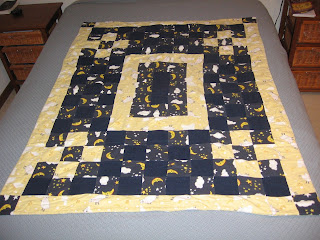Last weekend my friend
Becky came to visit. It turned into a very crafty weekend. My father hosted a luau, and wanted a palm tree for decorations. He found a few ideas online of trees made out of carpet rolls and an umbrella covered in leaves. Friday night Becky arrived and we went to work. I already had an umbrella that was slightly broken. I'd never replaced it because it wasn't very broken, just one of the spokes, but every time I used it it would get caught in my hair, which was really annoying. I was happy for an excuse to replace it. We headed to the dollar store to find something to make the leaves out of. The only paper big enough that we could think of was bristol board, but we felt like that would be too stiff for our purposes. Turns out the dollar store only had blue and red bristol board anyways, but we found a green plastic table cloth we thought would do the trick.
When we got home Becky made a template out of newspaper. She decided to make eight leaves, one for each section of the umbrella. She also decided to make the top of the leaf long and flat, to overlap across the top of the umbrella. It worked out perfectly that the length she made the leaf was the exact width of half the tablecloth. We decided the plastic was a little thin, so we doubled it over for each leaf. It also worked out perfectly that the width of the leaf was 1/8th of the length of the tablecloth, so we folded the tablecloth into 8 sections, and she was able to cut all of the leaves out at once. This was a real time saver. She also cut notches up the sides of the leaves to give them that palm tree look. Once they were all cut out she attached them temporarily with tape, and then stitched across the top of them with thread to permanently hold them on. We also drew veins down the leaves and out to the sides with a green sharpie. We didn't decide on this until after the leaves were attached. Next time, we would do that before hand.
 |
| Here Becky is stitching on the leaves. |
 |
I think it's still a viable option as an umbrella.
(The tablecloth is plastic) |
It even folded back up to be shipped off to the party! My dad cut out the black parts of the umbrella down at the bottom where the leaves didn't cover everything, and stuck it in the carpet roll. I will post a picture of the finished product later. It is currently set up in my parents living room and is a cheery addition, particularly for winter. Over all it took about an hour and a half to make.
[Disclaimer: The term "we" is used strictly in the most general sense. Becky did all of the work. I was making name tags and stuffing envelopes, and consulting on palm tree decisions.]
The second thing we did was take a trip to the states to go to Joann's. It is only about half an hour for us to get to Joann's (depending on the border) and I have a hard time doing any sewing projects without going there because fabric in Canada is so expensive. Becky had seen some ideas online about making a tablecloth that she had wanted to try. We saw in the flyer that muslin was $1.99/yard, so off we went. Apparently muslin wasn't actually on sale, so she didn't end up getting any. As a consolation prize flannel was 60% off and I had a coupon for 20% off your entire purchase, plus Becky's work is having a Christmas breakfast where you are supposed to wear pyjamas, so she decided she would make some.
As a side note, the fabric she bought would have regularly been $21 and she got it for $7. That's not too shabby I think. Everything we ended up buying was on sale, so we managed to hit up Hobby Lobby, Target and Joann's for $35. The guy at the border laughed at us and asked if we bought more than one thing. Also, a second side note: All of the flannel said it was not intended for use in children's sleepwear. We didn't really know what that meant, but we figured since we are not children we were fine. And now back to our regularly scheduled programming. Since Becky doesn't have a sewing machine buying the flannel meant we had to get the pyjamas made before she went back home. We got started right away cutting out the pattern. We also took it up to be serged(is that a verb?) by a friend of mine. There were only three seams. Neither Becky nor I had seen an serger in action before. Becky didn't even know what they did. (They finish the edge of the seam so it looks like anything you would buy from the store, and they cut off excess fabric at the same time). After that all that was left was to fold over the top, feed the elastic through, and hem the bottoms. They also have a drawstring, but she was going to get something from Michaels and feed that through at home. She is going to be styling at her breakfast.
All in all, it was a very successful and crafty weekend.















